Abstract
Privacy and confidentiality are essential for any patient-related information, including medical images. In this paper, a novel image encryption technique for medical images is introduced. This method is based on a four-dimensional (4D) hyperchaotic map, used to generate four substitution-boxes (S-boxes), employed for medical image encryption. The main advantage of this new method is its sensitivity toward attacks, making it highly secure. The encryption process starts by shuffling the plain image using a three-dimensional (3D) Chen map. This step is followed by the subdivision of the image into four sub-images. The third step involves replacing the pixel values in each of the sub-images with corresponding values from one of the four S-boxes. The pre-final step is the combination of the four sub-images, followed by the diffusion of this combined image while using a one-dimensional (1D) logistic map. This results in the final encrypted image. To test the efficiency of this new encryption technique, a 256 × 256 lost block within the encrypted image are subject to different types of attacks using numerical simulation. In the simulation analysis, the encrypted images are also subjected to salt and pepper noise, with the following values: 0.005, 0.05, and 0.1. The pixel correlation coefficient for images encrypted with the tested algorithm is found to be between 0.00241 and -0.000052 in the horizontal direction, between -0.00181 and -0.000952 in the vertical direction, and between 0.00263 and -0.000071 in the diagonal direction. As for information entropy, its value is close to 8 (the ideal value), between 7.9991 and 7.9994. The Unified Average Changing Intensity (UACI) ranged between 0.2857 and 0.3938, and the Number of Pixel Change Rate (NPCR) was between 0.9958 and 0.9962. These ranges are in the proximity of the optimum values for these variables. The results of encryption of other conventional encryption techniques, such as fractional discrete cosine transform with chaotic function, image encryption in the dual domain, and hybrid chaotic DNA diffusion, were compared to those of the proposed technique, which proved to be more effective and yields better results when used for medical image encryption.














Similar content being viewed by others
Data availability
All data are available upon request from the corresponding author.
References
Açikkapi Mehmet Şahin, Özkaynak Fatih (2020) A method to determine the most suitable initial conditions of chaotic map in statistical randomness applications. IEEE Access 9:1482–1494
Alarood AlaaAbdulsalm et al (2022) IES: Hyper-chaotic plain image encryption scheme using improved shuffled confusion-diffusion. Ain Shams Engineering Journal 13(3):101583
Alghamdi Y, Munir A, Ahmad J (2022) A Lightweight Image Encryption Algorithm Based on Chaotic Map and Random Substitution. Entropy 24(10):1344
Alkhayyat Ahmed et al (2022) A Novel 4D Hyperchaotic System Assisted Josephus Permutation for Secure Substitution-Box Generation. J. Signal Process. Syst. 94(3):315–328
Al-Saidi Nadia MG et al (2020) A new hyperchaotic map for a secure communication scheme with an experimental realization. Symmetry 12(11):1881
Bashir Z, Iqbal N, Hanif M (2021) A novel gray scale image encryption scheme based on pixels’ swapping operations. Multimedia Tools and Applications 80(1):1029–1054
Belazi Akram et al (2019) Novel medical image encryption scheme based on chaos and DNA encoding. IEEE access 7:36667–36681
Chai Xiuli et al (2019) Medical image encryption algorithm based on Latin square and memristive chaotic system. Multimedia Tools and Applications 78(24):35419–35453
Chaudhary Nirmal, Shahi Tej Bahadur, Neupane Arjun (2022) Secure Image Encryption Using Chaotic, Hybrid Chaotic and Block Cipher Approach. Journal of Imaging 8(6):167
Dagadu JC, Li J-P, Aboagye EO (2019) Medical image encryption based on hybrid chaotic DNA diffusion. Wireless Pers Commun 108(1):591–612
Deb S, Bhuyan B (2021) Chaos-based medical image encryption scheme using special nonlinear filtering function based LFSR. Multimedia Tools and Applications 80(13):19803–19826
El-Khamy SE, Korany NO, Mohamed AG (2020) A new fuzzy-DNA image encryption and steganography technique. IEEE Access 8:148935–148951
El-Shafai Walid et al (2021) Robust medical image encryption based on DNA-chaos cryptosystem for secure telemedicine and healthcare applications. J Ambient Intell Humaniz Comput 12(10):9007–9035
Farah MA, Farah A, Farah T (2020) An image encryption scheme based on a new hybrid chaotic map and optimized substitution box. Nonlinear Dyn 99(4):3041–3064
Girdhar A, Kapur H, Kumar V (2021) A novel grayscale image encryption approach based on chaotic maps and image blocks. Appl Phys B 127(3):1–12
Gu G, Ling J (2014) A fast image encryption method by using chaotic 3D cat maps. Optik 125(17):4700–4705
Guesmi Ramzi, Farah MA (2021) A new efficient medical image cipher based on hybrid chaotic map and DNA code. Multimedia tools and applications 80(2):1925–1944
Gupta A, Singh D, Kaur M (2020) An efficient image encryption using non-dominated sorting genetic algorithm-III based 4-D chaotic maps. J Ambient Intell Humaniz Comput 11(3):1309–1324
Hanif Muhammad et al (2022) A novel grayscale image encryption scheme based on the block-level swapping of pixels and the chaotic system. Sensors 22(16):6243
Huang X, Ye G (2014) An efficient self-adaptive model for chaotic image encryption algorithm. Commun Nonlinear Sci Numer Simul 19(12):4094–4104
Idrees Bazgha et al (2020) Image encryption algorithm using S-box and dynamic Hénon bit level permutation. Multimedia Tools and Applications 79(9):6135–6162
Iqbal N, Hanif M (2021) An efficient grayscale image encryption scheme based on variable length row-column swapping operations. Multimedia Tools and Applications 80(30):36305–36339
John Siju, Kumar SN (2023) 2D Lorentz Chaotic Model Coupled with Logistic Chaotic Model for Medical Image Encryption: Towards Ensuring Security for Teleradiology. Procedia Comput. Sci. 218:918–926
Kaur M, Kumar V (2020) A comprehensive review on image encryption techniques. Arch. Comput. Methods Eng. 27(1):15–43
Khalil Noura, Sarhan Amany, Alshewimy Mahmoud AM (2021) An efficient color/grayscale image encryption scheme based on hybrid chaotic maps. Opt. Laser Technol. 143:107326
Khan Jan Sher et al (2020) DNA and plaintext dependent chaotic visual selective image encryption. IEEE Access 8:159732–159744
Khan Jan Sher, Ahmad Jawad (2019) Chaos based efficient selective image encryption. Multidimens. Syst and Signal Process 30(2):943–961
Kumar Sumit, Panna Bhaskar, Jha Rajib Kumar (2019) Medical image encryption using fractional discrete cosine transform with chaotic function. Med. Biol. Eng. Comput. 57(11):2517–2533
Lee Wai-Kong et al (2018) SPRING: a novel parallel chaos-based image encryption scheme. Nonlinear Dyn. 92(2):575–593
Li Taiyong et al (2019) Image encryption based on pixel-level diffusion with dynamic filtering and DNA-level permutation with 3D Latin cubes. Entropy 21(3):319
Li Chun-Lai et al (2021) Image encryption scheme with bit-level scrambling and multiplication diffusion. Multimedia Tools and Applications 80(12):18479–18501
Liu Jizhao et al (2018) A new simple chaotic system and its application in medical image encryption. Multimedia Tools and Applications 77(17):22787–22808
Liu H, Zhao Bo, Huang L (2019) Quantum image encryption scheme using Arnold transform and S-box scrambling. Entropy 21(4):343
Lu Yang et al (2023) Exploiting 3D fractal cube and chaos for effective multi-image compression and encryption. J King Saud University-Comp Inform Sci 35(3):37–58
Mirzaei O, Yaghoobi M, Irani H (2012) A new image encryption method: parallel sub-image encryption with hyper chaos. Nonlinear Dyn 67(1):557–566
Mohamed HG, ElKamchouchi DH, Moussa KH (2020) A novel color image encryption algorithm based on hyperchaotic maps and mitochondrial DNA sequences. Entropy 22(2):158
Mohamed AG, Korany NO, El-Khamy SE (2021) New DNA coded fuzzy based (DNAFZ) S-boxes: Application to robust image encryption using hyper chaotic maps. IEEE Access 9:14284–14305
Pareek NK, Patidar V, Sud KK (2013) Diffusion–substitution based gray image encryption scheme. Digit. Signal Process. 23(3):894–901
Patro K. Abhimanyu, Kumar, et al (2020) Multiple grayscale image encryption using cross-coupled chaotic maps. J. Inf. Secur. Appl 52:102470
Qayyum Abdullah et al (2020) Chaos-based confusion and diffusion of image pixels using dynamic substitution. IEEE Access 8:140876–140895
Ravichandran Dhivya et al (2021) An efficient medical image encryption using hybrid DNA computing and chaos in transform domain. Med. Biol. Eng. Comput. 59(3):589–605
Raza Saiyma Fatima, Satpute Vishal (2019) A novel bit permutation-based image encryption algorithm. Nonlinear Dyn. 95:859–873
Stalin Shalini et al (2019) Fast and secure medical image encryption based on non linear 4D logistic map and DNA sequences (NL4DLM_DNA). J. Med. Syst. 43(8):1–17
Talhaoui Mohamed Zakariya, Wang Xingyuan, Midoun Mohamed Amine (2021) Fast image encryption algorithm with high security level using the Bülban chaotic map. J Real Time Image Process 18(1):85–98
Vaseghi Behrouz et al (2021) Fast reaching finite time synchronization approach for chaotic systems with application in medical image encryption. IEEE Access 9:25911–25925
Wang Xiong et al (2019) S-box based image encryption application using a chaotic system without equilibrium. Appl. Sci. 9(4):781
Wang X, Xue W, An J (2020) Image encryption algorithm based on tent-dynamics coupled map lattices and diffusion of household. Chaos, Solitons Fractals 141:110309
Wang X, Guan N, Yang J (2021) Image encryption algorithm with random scrambling based on one-dimensional logistic self-embedding chaotic map. Chaos, Solitons Fractals 150:111117
Xingyuan W, Junjian Z, Guanghui C (2019) An image encryption algorithm based on ZigZag transform and LL compound chaotic system. Opt Laser Technol 119:105581
Xu J, Zhao B, Zeming Wu (2022) Research on color image encryption algorithm based on bit-plane and Chen Chaotic System. Entropy 24(2):186
Zareai D, Balafar M, Derakhshi MRF (2021) A new Grayscale image encryption algorithm composed of logistic mapping, Arnold cat, and image blocking. Multimedia Tools and Applications 80(12):18317–18344
Zhan Kun et al (2017) Cross-utilizing hyperchaotic and DNA sequences for image encryption. J. Electron. Imaging 26(1):013021
Zhang Y (2016) The image encryption algorithm with plaintext-related shuffling. IETE Tech Rev 33(3):310–322
Zhang L, Zhang X (2020) Multiple-image encryption algorithm based on bit planes and chaos. Multimedia Tools and Applications 79:20753–20771
Zhou Yang et al (2021) Image encryption algorithm with circle index table scrambling and partition diffusion. Nonlinear Dyn. 103(2):2043–2061
Gao Yuan, and Chenghua Liang (2013). "A new 4D hyperchaotic system and its generalized function projective synchronization." Math. Probl. Eng. 2013
Nestor Tsafack, et al (2022) "A new 4D hyperchaotic system with dynamics analysis, synchronization, and application to image encryption." Symmetry 14.2 424
Farwa Shabieh et al (2017) "An image encryption technique based on chaotic S-box and Arnold transform." International Journal of Advanced Computer Science and Applications 8.6
Brahim A, Hadj A, Ali Pacha, and N HADJ Said (2023) "A new image encryption scheme based on a hyperchaotic system & multi specific S-boxes." Information Security Journal: A Global Perspective 32.2: 59-75
Tootkaboni Mohammad Akbari, and Meisam Bavand Savadkouhi (2023) "S-Boxes Design Based On the Lu-Chen System And Their Application in Image Encryption
Asif Muhammad et al (2021) "A Novel Image Encryption Technique Based on Mobius Transformation." Comput. Intell. Neurosci. 2021
Masood Fawad et al (2021) "A lightweight chaos-based medical image encryption scheme using random shuffling and XOR operationsWirel. Pers. Commun. 1–28
Banu S, Aashiq, and Rengarajan Amirtharajan (2020) "A robust medical image encryption in dual domain: chaos-DNA-IWT combined approach." Med. Biol. Eng. Comput. 58.7: 1445-1458
Puja Vyavahare, Prof. Harish Barapatre, Prof. NilimaNikam (2019) “Analysis of Chaotic, Hyperchaotic and DNA Sequence for Image Encryption”
Javan Ali Akbar Kekha et al (2021) "Medical images encryption based on adaptive-robust multi-mode synchronization of chen hyper-chaotic systems." Sensors 21.11: 3925. El-Khamy, Said E., and Amira G. Mohamed. "An efficient DNA-inspired image encryption algorithm based on hyper-chaotic
Pavithra V, and C Jeyamala (2018) "A survey on the techniques of medical image encryption." 2018 IEEE Int. Conf. Comput. Intell. Commun.Res (ICCIC). IEEE
Dutta, Wriddhirup, Soumik Mitra, and S. Kalaivani (2017) "Audio encryption and decryption algorithm in image format for secured communication." 2017 International Conference on Inventive Computing and Informatics (ICICI). IEEE
Al-KateebZeena N, Muna Jaffer Al-Shamdeen, and Farah Saad Al-Mukhtar (2020) "Encryption and Steganography a secret data using circle shapes in colored images." J. Phys. Conf. Ser.. Vol. 1591. No. 1. IOP Publishing
Tarabay Samaa Y, et al "A Secure and Efficient Cryptography System Based on Chaotic Maps for Securing Data Image in Fog Computing"
Gafsi Mohamed et al (2020) "Improved chaos-based cryptosystem for medical image encryption and decryption." Scientific Programming 2020
Niu, Ying, Xuncai Zhang, and Feng Han (2017) "Image encryption algorithm based on hyperchaotic maps and nucleotide sequences database." Comput. Intell. Neurosci. 2017
Ebrahim, Seham Muawadh Ali (2020) "Hybrid Chaotic Method for Medical Images Ciphering." arXiv preprint arXiv:2012.02865
Diaconu, Adrian-Viorel, and Khaled Loukhaoukha (2013) "An improved secure image encryption algorithm based on Rubik's cube principle and digital chaotic cipher. Math. Probl. Eng. 2013
Acknowledgements
The authors are very grateful to all the institutions in the affiliation list for successfully performing this research work. The authors would like to thank Prince Sultan University for their support.
Funding
The authors did not receive support from any organization for the submitted work.
Author information
Authors and Affiliations
Contributions
All authors are equally contributed.
Corresponding author
Ethics declarations
Ethics approval and consent to participate
All authors are contributing and accepting to submit the current work.
Consent for publication
All authors are accepting to submit and publish the submitted work.
Competing interests
The authors have no relevant financial or non-financial interests to disclose.
Additional information
Publisher's note
Springer Nature remains neutral with regard to jurisdictional claims in published maps and institutional affiliations.
Rights and permissions
Springer Nature or its licensor (e.g. a society or other partner) holds exclusive rights to this article under a publishing agreement with the author(s) or other rightsholder(s); author self-archiving of the accepted manuscript version of this article is solely governed by the terms of such publishing agreement and applicable law.
About this article
Cite this article
Ahmed, S.M., M.A.Elkamchouchi, H., Elfahar, A. et al. A hybrid medical image cryptosystem based on 4D-hyperchaotic S-boxes and logistic maps. Multimed Tools Appl 83, 8837–8865 (2024). https://doi.org/10.1007/s11042-023-15925-6
Received:
Revised:
Accepted:
Published:
Issue Date:
DOI: https://doi.org/10.1007/s11042-023-15925-6




